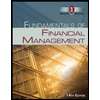
Concept explainers
Nonconstant Growth [LO1] This one’s a little harder. Suppose the current share price for the firm in the previous problem is $44.50 and all the dividend information remains the same. What required return must investors be demanding on Storico stock? (Hint: Set up the valuation formula with all the relevant cash flows, and use trial and error to find the unknown
To determine: The required rate of return
Introduction:
Rate of return is a loss or gain incurred on the investment made by the investors. It is expressed in terms of percentage. Stock is a type of security in a company which denotes ownership. On issuing stocks, the company can raise capital.
Answer to Problem 35QP
The required rate of return is 13.10%.
Explanation of Solution
Given information:
SC Company has paid off dividends of $2.65 per share. The company increased dividends by 20% for the next year and the company even reduced its dividends’ growth rate by 5%.
The formula to calculate the required rate of return using stock price formula:
Where,
Po refers to the price of the stock of current year
Do refers to the current year dividend paid
R refers to the required rate of return on its stock
g1 refers to the expected growth rate of dividend
g2 refers to the constant rate of growth in second year
g3 refers to the constant rate of growth in third year
gn refers to the constant rate of growth in n number of year
Compute the required rate of return using stock price formula:
Consider the last equation above as Equation (1). This last equation can be even simplified by using trial-and-error method, so assume the required rate of return (R) has 13%. Then, substitute the value of the required rate of return in Equation (1) which is shown below:
Hence, the required rate of return is not 13% since the current stock price, $44.50, is not equal to the derived value (stock price) to the assumed required rate of return (R) as per the trial-and-error method. Next, assume the required rate of return has 13.10% to the same Equation (1), which is shown below:
Hence, the required rate of return is 13.10%. It is because the current stock price, $44.50, is equal to the derived (stock price) value to the assumed required rate of return (R) as per the trial and error method.
Want to see more full solutions like this?
Chapter 8 Solutions
Fundamentals of Corporate Finance
 Fundamentals of Financial Management (MindTap Cou...FinanceISBN:9781285867977Author:Eugene F. Brigham, Joel F. HoustonPublisher:Cengage Learning
Fundamentals of Financial Management (MindTap Cou...FinanceISBN:9781285867977Author:Eugene F. Brigham, Joel F. HoustonPublisher:Cengage Learning
